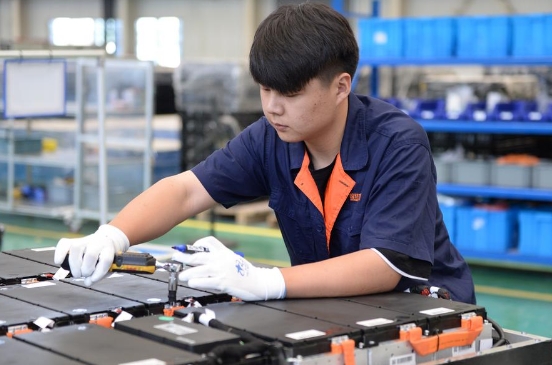How China's batteries are powering global energy shift

A worker is busy at a battery company plant of Gotion High-tech Co., Ltd. in Hefei, east China's Anhui Province, June 19, 2020. (Xinhua/Huang Bohan)
When we talk about modern life, we cannot ignore the crucial role played by electricity. With the flip of a switch, our life becomes so convenient, broad and bright.
Among the more significant developments in this field is the invention of the power battery. By storing enough energy to power equipment intermittently and for ever longer periods of time, batteries have reshuffled the way we live, allowing us to power almost everything from small electronic gadgets to family cars.
Now battery packs are reshaping the automotive industry.
Recently, I had the opportunity to visit Gotion High-tech Co., Ltd., one of the earliest Chinese manufacturers to develop power batteries for new energy vehicles (NEVs).
I was wowed by their ultra-modern products, with the combination of state-of-the-art technology and novel appearance.
In the company's exhibition center, I saw an array of batteries of various sizes and shapes. At first glance, it looked something like a computer workshop. The battery packs resembled either computer mainframes or large chip boards, depending on the scenarios to which they apply.
Inside the cases, electrodes and electrolytes work their magic. Global NEV battery makers have optimized the formulas through technological innovation, achieving faster charging rates, longer endurance and higher stability, so as to better address the "range anxiety" of NEV users.
Gotion is no exception. The company believes that range anxiety is in essence an anxiety about charging.
Talking with Cheng Qian, Gotion's president of Asia-Pacific Business and director of its international engineering research institute, I was impressed by the company's newly-released "Stellary" battery. Adopting self-developed new materials and with a higher energy density, it can be charged from 10 percent to 70 percent within nine minutes.
The market potential in the field of power battery is huge. Projections from the International Energy Agency (IEA) suggest that by 2030, global demand for NEVs will surpass last year's figures threefold, reaching 45 million vehicles, with power battery demand skyrocketing to 3,500 GWh.
In recent years, China's innovation and manufacturing prowess has made green technologies more affordable, putting them on a faster development track, both inside and outside the country.
Through competition and cooperation with overseas peers, Chinese automakers have also cultivated a robust competitive environment and contributed their share to the green energy shift.
Another Anhui-based energy-storage supplier, Sungrow Power Supply Co., Ltd., has set up its European headquarters, Sungrow Europe, in Munich, Germany.
The new headquarters mainly provides photovoltaic inverters, energy-storage systems and other products to meet market demand for local projects, according to Moritz Rolf, vice president of Sungrow Europe.
Rolf said that Sungrow Europe has more than 500 employees, of which 90 percent are local European employees, who play a vital role in the development of various business areas.
It became clear to me that China's battery output capacity was never a one-sided story dominated by China. The output was driven by the specific problems and needs of countries seeking to promote e-mobility and the improvement of livelihoods, and Chinese enterprises were ready and willing to seize the opportunities.
Clearly, no company can claim it is capable of doing everything. Just as a battery is only part of an NEV or a power station, one or two countries alone cannot constitute a global supply chain.
Besides, the cooperation on production capacity is a two-way street, with foreign companies also seeking investment opportunities in China's energy transition. For example, German automaker Volkswagen Group has already become Gotion's largest shareholder, as part of its move to build up local NEV production capacity in Hefei.
According to the IEA, China accounts for almost 60 percent of new renewable capacity expected to become operational globally by 2028. This makes China a major contributor to the global goal of tripling the world's renewable capacity by 2030.
If one includes the amount of renewable capacity that China helps other countries to build, the number grows even bigger. While China is realizing its own green development, it is also providing support to the international community through various cooperative projects.
The development of green industries continues to gain in importance in government agendas across the globe. The green industrial sector is both a big cake and a competitive racetrack for those global companies involved. If they wish to remain at the forefront of this field, they must hone their competitive edge through innovation and cooperation.
Editor:伏娅敏
